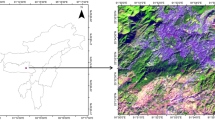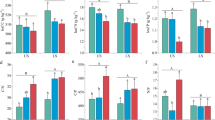Abstract
Within the perhumid, Atlantic lowlands of northern Costa Rica, Cordia alliodora plantations were studied in order to explain the observed pattern of growth irregularities. The soils, that were partly used as pastures over long periods, could be classified roughly into two units: (i) red, deeply weathered, slightly acidic soils from Mg-enriched parent material and (ii) brown, strongly acidic soils with high saturation of exchangeable Al (up to 80%).
Leaf analysis revealed that Cordia is a highly demanding species in respect to macronutrients. Poorly growing trees in slope position suffered from an insufficient supply of N and P. K/Mg ratios of chlorotic leaves are very low. Soil analysis showed that nutrient deficiencies were related to (i) insufficient soil nutrient reserves of the poor, tropical soils or (ii) to an inhibition of nutrient uptake by soil physical or chemical factors.
All sites are characterized by very low K reserves and losses of nutrients that are organically bound (N, P) caused by erosion. In the Mg-rich red soils, low amounts of K lead to K/Mg imbalances. Soil compaction caused by cattle grazing occurs on both soil units. In negatively influences the root development of Cordia, and hence nutrient uptake. In the brown soils, high amounts of exchangeable Al hinder a sufficient supply of nutrients (e.g.P) to the assimilation organs.
Similar content being viewed by others
References
AG Bodenkunde 1982 Bodenkundliche Kartieranleitung. Hannover, Germany. 331 p.
Benites J R 1990 Agroforestry systems with potential for acid soils of the humid tropics of Latin America and the Carribean. For. Ecol. Manage. 36, 81–101
Carvajal J F 1978 El diagnóstico del estado de nutrición de los cultivos. Agron. Costarr. 2 (2), 175–183.
Condit R, Hubbell S P and Foster R B 1993 Identifying fast-growing native trees from the Neotropics using data from a large, permanent census plot. For. Ecol. Manage. 62, 123–143.
CONIF (Corporacion Nacional De Investigacion y Fomento Forestal) 1988 Cordia alliodora (Ruiz and Pavon) Oken: Experiencias en Colombia. Convenio CONIF-HOLANDA. Bogotá, 1988. Serie Documentación No. 15. 42p.
Drechsel P and Zech W 1991 Foliar nutrient levels of broad-leaved tropical trees: A tabular review. Plant and Soil 131, 29–46.
Hartshorn G S 1982 Costa Rica-Perfil Ambiental. Centro Científico Tropical San José, Costa Rica.
Johnson P and Morales R 1972 A review of Cordia alliodora (Ruiz and Pav.) Oken. Turrialba 22 (2), 210–220.
Lamprecht H 1986 Waldbau in den Tropen. Parey, Hamburg, Germany. 318 p.
Martini J A and Macias M 1974 A study of six Latosols from Costa Rica to elucidate the problems of classification, productivity and management of tropical soils. Soil Sci. Soc. Am. Proc. 38, 644–652.
Montagnini F and Sancho F 1990 Impacts of native trees on tropical soils: A study in the Atlantic lowlands of Costa Rica. Ambio 19 (8), 386–390.
Olsen S R and Sommers L E 1982 Phosphorus. In Methods of Soil Analysis, part 2. Eds. A L Page, R H Miller and D R Keeney. pp 403–427. Am. Soc. Agron. 9, Madison, Wisconsin, USA.
Sandner G and Nuhn H 1971 Das nördliche Tiefland von Costa Rica. Abh. Gebiet d. Auslandskunde Bd. 72, Reihe C, Bd. 21. Walter de Gruyter, Berlin.
Spaans E J A, Baltissen G A M, Bouma J, Miedema R, Lansu A L E, Schonderbeek D and Wielemaker W G 1989 Changes in physical properties of young and old volcanic surface soils in Costa Rica after clearing of tropical rainforest. Hydrol. Process 3, 383–392.
Stuhrmann M, Bergmann C and Zech W 1994 Mineral nutrition, soil factors and growth rates of Gmelina arborea plantations in the humid lowlands of northern Costa Rica. For. Ecol. Manage. (In press).
VonUexkull H R 1986 Efficient fertilizer use in acid upland soils of the humid tropics. FAO Fertilizer and Plant Nutrition Bulletin 10, FAO, Rome. 59 p.
Weaver P 1979 Agri-silviculture in tropical America. Unasylva 31, 2–12.
Wielemaker W G and Lansu A L E 1991 Land-use changes affecting classification of a Costa Rican soil. Soil Sci. Soc. Am. J. 55, 1621–1624.
Zech W and Drechsel P 1992 Multiple mineral deficiencies in forest plantations in Liberia. For. Ecol. Manage. 48, 121–143.
Author information
Authors and Affiliations
Rights and permissions
About this article
Cite this article
Bergmann, C., Stuhrmann, M. & Zech, W. Site factors, foliar nutrient levels and growth of Cordia alliodora plantations in the humid lowlands of Northern Costa Rica. Plant Soil 166, 193–202 (1994). https://doi.org/10.1007/BF00008333
Received:
Accepted:
Issue Date:
DOI: https://doi.org/10.1007/BF00008333




